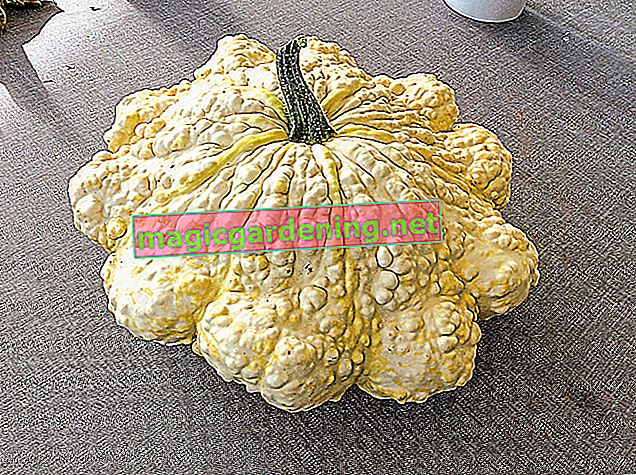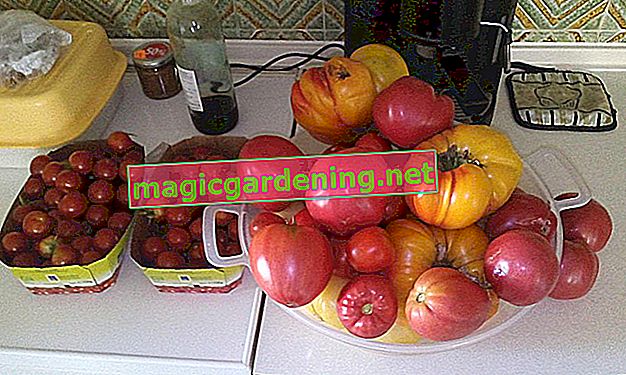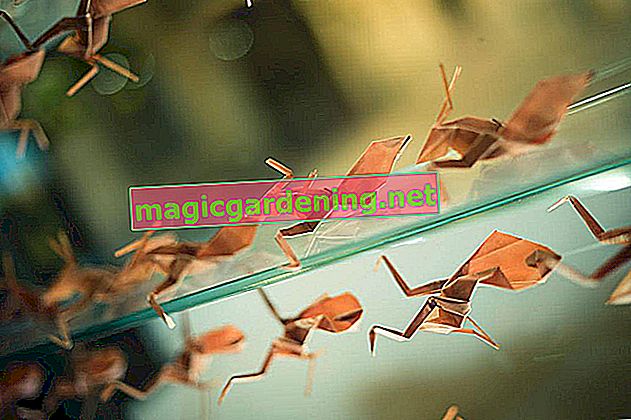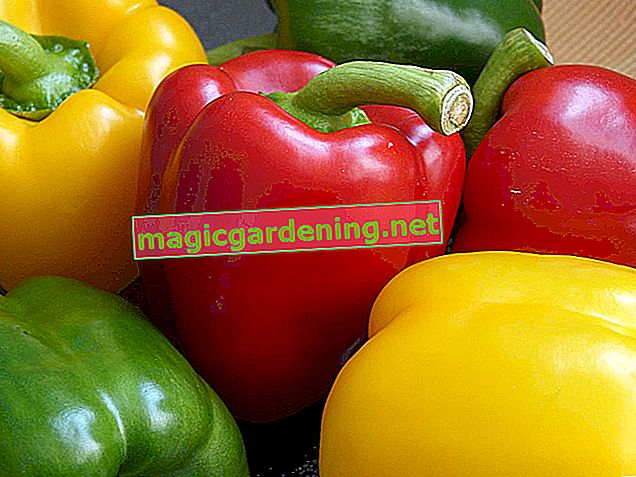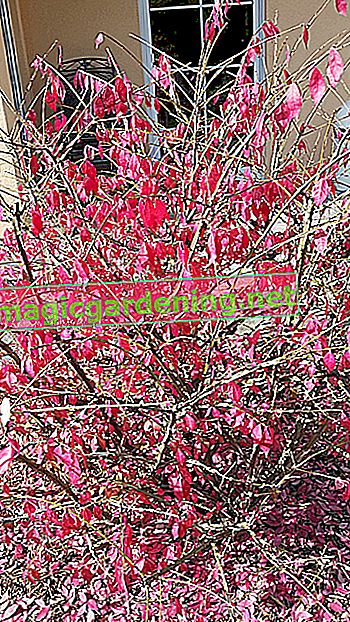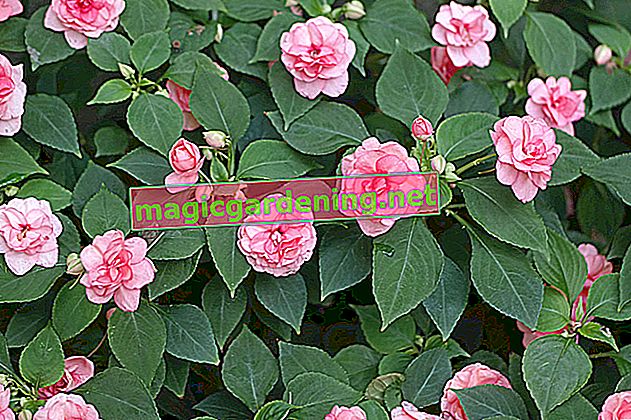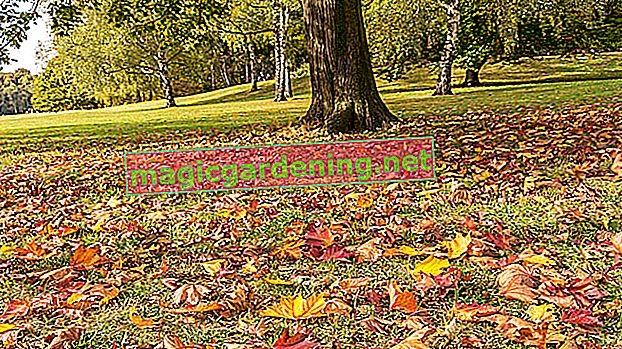
Origin and Distribution
The garden petunia that is so popular with us is strictly speaking not a species of its own, but a hybrid of the violet petunia (Petunia integrifolia) and the white petunia (Petunia axillaris) that was bred out in the 19th century. It is characterized by a large variety of flower colors and growth forms, is easy to care for and extremely floriferous.
also read
- Plant petunias in the garden or on the balcony
- Skillfully care for petunias as balcony plants - this is how it works
- White coating on the petunias: what is it?
The original wild forms come from the climatically moderate to subtropical regions of South America and are particularly widespread in Brazil, Bolivia, Paraguay, Argentina and Uruguay. It is also not a single species, but a separate genus of plants with around 16 different species. Petunias (bot. Petunia) belong to the nightshade family (Solanaceae) and are closely related to the tobacco plant (Nicotiana). The name of the plant also refers to this: “Petun” means nothing other than “tobacco” in one of the native languages of Brazil, Guarani.
The petunias available on the market are usually garden petunias; special species and their varieties are rarely offered.
use
Because of their climbing, dense growth and the abundance of flowers, petunias are popular permanent flowering plants for flower boxes (€ 13.18 on Amazon *) or hanging baskets as well as for pots. Here the colorful blooming miracles are suitable both for dense planting - either alone or in combination with other species - as well as for solitary use. Furthermore, petunias can be used excellently as underplanting tall trunks or other woody plants, for example as a supplement to hybrid tea roses or convertible florets.
But not only on the balcony, petunias also cut a good figure in the garden bed. Especially with other annual, fast-growing summer flowers such as
- Tagetes
- Verbenas
- Pelargonium
- Lobelia
- Snowflake flowers
- Fuchsias
- or sun hat
the flowers form a suitable alliance. Those who do not want to distract from the flowers with other flowering plants can combine petunias with ornamental foliage plants such as multicolored nettle or Gundermann. Herbs, especially Mediterranean ones such as sage, thyme, oregano, etc., as well as vegetables can also be very well associated with the uncomplicated petunia.
Incidentally, blooming petunias fulfill a very practical purpose on the balcony or terrace: The plant is supposed to drive away annoying mosquitoes that don't like the scent of the flowers at all. This works particularly well if you plant the flowers together with other plants that mosquitoes do not like. For example, lavender, rosemary, basil, but also lemon balm, marigolds and tomatoes are suitable.
Appearance and stature
Strictly speaking, the petunia is not a flower, but a fast-growing and shrubby herb. The garden petunias, which are usually grown as an annual, can reach heights of between 20 and 70 centimeters, depending on the variety. The gardener differentiates between upright and hanging petunias. These varieties, also known as cascade petunias, develop long shoots covered with numerous flowers and are therefore particularly suitable for planting in hanging baskets or window boxes. (€ 106.25 at Amazon *)
The magic bells (calibrachoe), which are very similar in appearance to a petunia, are not small-flowered varieties, but a separate plant genus. However, both the magic bells and the petunias belong to the nightshade family (Solanaceae) and are therefore closely related to each other.
leaves
The dark green, entire, slightly hairy leaves of the petunia form a strong contrast to the strong, fresh colors of the trumpet-shaped flowers. The plant hairs, also known as trichomes, are often sticky. Typically, the petunia's stalked leaves are arranged alternately, although there are also species and varieties with leaves sorted in pairs.
Blossoms and flowering period
The garden petunias are classically divided into four different groups according to the size and abundance of their flowers:
- Grandiflora petunias: very large, flat and trumpet-shaped flowers, individually on the stem, sensitive to rain
- Multiflora petunias: compact growth, numerous short-stalked flowers with a diameter of up to five centimeters, insensitive to rain
- Floribunda petunias: numerous flowers up to eight centimeters in size, sensitive to rain
- Milliflora petunias: numerous tiny flowers only between two and three centimeters in size
The so-called “rose petunias”, on the other hand, are varieties whose double, round flowers are reminiscent of rose blossoms.
Typical of all petunias are the delicate flowers shaped like a trumpet in numerous summer colors. In addition to single-colored varieties in white, pink, red, violet and blue, there are also fascinating varieties with spotted, star or striped patterned flowers. With all varieties, the lush splendor can be tirelessly admired between May and October with appropriate care.
Toxicity
As with almost all nightshade plants, the green plant parts of the petunia contain solanine and are therefore poisonous. In particular, the leaves must not be nibbled or eaten by humans or pets. However, petunias contain less of the poisonous solanine than potato plants, and the leaves, which are scratchy due to their hair, do not taste particularly good.
Typical symptoms of intoxication such as nausea, diarrhea and vomiting occur when consumed. However, mere touch does not produce these signs. However, the sticky plant hairs can trigger allergies in sensitive people, which manifest themselves in symptoms such as itching, reddened and / or irritated skin. For asthmatics, however, the flowers are harmless.
Which location is suitable?
Petunias bloom all the more beautifully the sunnier they are. A warm, wind and rain-protected location is therefore best for the summer blooming flowers, regardless of whether they are on the balcony or in the garden bed. Heat and blazing sun do not damage the lush bushes with the delicate flowers, but they are sensitive to wind, cold and rain - and the larger the flowers are, the more so. The Grandiflora varieties in particular belong in a place protected from rain, as the colors of the large flowers are quickly washed out by moisture. Small-flowered variants, on the other hand, are significantly more robust against weather influences.
Those who cannot offer their petunias a full sun location should plant them in the light penumbra. There the plants also thrive very well, but then do not develop as many flowers.
Substrate / soil
The use of special petunia soil, which is available in every DIY store and garden center, is recommended for keeping in a bucket. Usually, however, commercially available compost-based potting soil is completely sufficient. Make sure, however, that you choose high-quality potting soil without any peat. Inferior substrates often lead to yellowed or otherwise discolored leaves, because after a while there is an iron deficiency due to unsuitable soil and / or insufficient supply.
If, on the other hand, the petunias are to be planted in the garden borders, you should plant them in loose, humus-rich, well-drained soil and, if necessary, enrich it with ripe compost or manure.
Prefer
In spring, the various types of petunia are available at low prices in stores. Those who enjoy growing their own plants can also win their own petunias as purchased or collected seeds. Please note, however, that the hybrid varieties in particular can be sterile (ie no viable seeds can be obtained) or that they do not reliably pass on their properties to their offspring. This is especially true for hanging petunias, whose descendants often have an upright growth. Propagation via seeds is always a surprise anyway, since different characteristics are always mixed up again.
You can grow petunias on the windowsill as early as January, although sowing between February and March is still completely sufficient. The plants are light germinators, which is why the seeds are not covered with potting soil, but should only rest on it. Always keep the substrate slightly moist and place the seed pot in a light, but not directly sunny and around 20 ° C warm location. At best, cover it with a hood, which can also consist of a cut-off PET bottle or a film.
The seedlings are pricked out as soon as the second pair of leaves has developed. However, you should wait until mid / end of May before planting them out, because petunias are sensitive to frost and can be seriously damaged by late night frosts.
Planting petunias properly
Since petunias like to be in warm and full sun locations, they have a correspondingly high water requirement, which, however, must not degenerate into waterlogging. Correspondingly, it is important to ensure good drainage, especially when it is kept in a bucket, for example by adding a layer of gravel to the bottom of the pot. This regulates the water balance and also ensures that excess water is quickly drained to the outside. To do this, there must be a drainage hole at the bottom of the pot, where the irrigation water flows into a saucer or into the planter. Remove it from this immediately after watering so that the plants do not get “wet feet”.
If the heavy, loamy garden soil tends to get wet or permanent moisture, drainage in the planting hole is also recommended here. To do this, spread a layer of gravel on the bottom of the planting hole and mix the excavated material with loose substrates such as compost soil, sand, etc. In any case, when planting outdoors, you should add generous amounts of compost to the planting hole to give the petunias sufficient nutrients to start with.
In the case of pots, you should not choose the planter too small so that the roots have plenty of space and the plants can develop well. Planting too tightly, on the other hand, not only leads to growth disorders, but also promotes diseases and pest infestation.
Before planting, put the plant in a bucket of water so that the roots can soak up the moisture. Also water carefully after planting and mulch the root area, for example with bark mulch. This ensures that the moisture in the soil does not immediately evaporate again, and the roots are also kept cool - in fact, unlike the above-ground parts of the plants, they do not like too much heat.
Continue reading
What is the best time to plant?
The frost-sensitive petunias are only allowed to go outside in late spring / early summer after you have gradually accustomed the young plants to a location in the fresh air. The flowers are severely damaged by sudden nocturnal frosts and should therefore be protected from them.
The correct planting distance
The optimal distance between two plants is about 15 centimeters.
Watering petunias
Even if petunias are considered easy to care for, they are anything but undemanding. They have to be regularly supplied with water, especially during the hot summer months, whereby the substrate must not dry out if possible. If this happens occasionally, brief drought is not a problem, but in the long run it will cause the plant to die. Petunias grown in planters, in particular, should be watered two to three times a day on hot, dry days.
The pretty flowering plants do not tolerate drought, but neither do they like waterlogging. You should therefore only water when necessary, based on the degree of dryness of the substrate: it will be time for a powerful watering from the watering can once the potting soil has dried on the surface. Use soft, lime-free water such as well-stale tap water or collected rainwater for watering. Hard water, on the other hand, can be problematic as it disrupts the nutrient supply. However, if you live in a region with lime-rich water, you can counteract the discolored leaves and diseases resulting from nutrient deficiency by filtering the tap water and adding a good iron fertilizer.
When watering, never moisten the leaves or flowers of the petunia, because this can lead to burns (water droplets act like burning glasses in the sun) or promote fungal diseases.
Continue reading
Fertilize petunias properly
The petunia needs a lot of nutrients for its abundant flowers and therefore needs regular fertilization. If the flowers are to be in the garden bed, give them a slow release fertilizer suitable for flowering plants in the planting hole. The compost that is also added will not meet the high nutritional requirements. Container plants, on the other hand, provide you with a phosphorus-based, liquid universal or flowering plant fertilizer, which you apply every two weeks or according to the manufacturer's instructions with the irrigation water. Phosphorus is essential for plants and promotes flower formation, while nitrogen primarily stimulates shoot growth. If the petunia develops yellow leaves, it suffers from an iron deficiency and should be supplied with a special iron fertilizer.
Cut petunias properly
Vigorous pruning is only necessary if you want to overwinter the petunias. In this case, use the scissors before moving to winter quarters and repeat this measure before clearing out in spring. At this point, you should remove thin and weak shoots that have grown over the winter.
Otherwise, just pluck off bloomed flowers during the flowering period, so that the plant keeps developing new inflorescences. In addition, withered shoots quickly become unsightly and sticky, which is why cutting off also has optical reasons. If you neglect cleaning, petunias will develop seed heads that you can collect shortly before ripening and keep in a dry and dark place over the winter. In order to prevent the faded inflorescences from sticking together, carefully pluck only the petals. Then a small, green ovary remains, from which the seed capsule eventually develops. Between January and March you can use the seeds in it to grow your own petunias.
Propagate petunias
In contrast to cultivation from seeds, petunias can be propagated by cuttings according to type. Since this form of propagation is basically clones of the mother plant, they have the same properties and you are safe from surprises. The easiest way to propagate cuttings is this:
- In early summer, cut off a 15 to 20 centimeter long secondary shoot.
- Remove all flowers from this.
- Pluck the leaves down to the pairs of leaves on the top five centimeters of the shoot.
- Put the cutting in a glass with soft water.
- Place the glass in a bright, not directly sunny location.
- Change the water every two days.
After about two to three weeks, the cutting will develop its first roots, so that you can plant it in suitable soil and cultivate it like any adult plant.
Continue reading
Overwinter
Since petunias are not frost-hardy and are available in great variety and for little money every year, they are usually only cultivated as an annual. In fact, they are perennial plants that you can overwinter with a little effort and replant in the coming spring. You have several options for this:
- Seeds: You only collect the seed pods with the seeds and overwinter them in order to use them in February to grow new plants. The petunias from last year, on the other hand, are composted in autumn.
- Plants: Hibernating adult plants, on the other hand, is a little more time-consuming. It is best to proceed as follows:
- Put petunias in their winter quarters before the first frost.
- Cut the plant back to about 20 centimeters.
- A bright, frost-free room that is between five and ten degrees cool is ideal.
- Protect petunias from heating air.
- Do not fertilize, just water a little occasionally.
In spring you slowly get the petunias used to the sun and warmth again, but you shouldn't put the plants outside too early. From April you also start with the right fertilization and gradually increase the watering frequency.
Continue reading
Diseases and pests
Petunias are quite robust plants, but due to poor care they can be attacked by diseases and / or pests. The following occur particularly frequently:
- Powdery mildew: occurs mainly in hot, warm weather, cut out infected parts of the plant generously and spray the infected plant several times with a mixture of whole milk and water
- Root rot: caused by constant moisture in the substrate / waterlogging, immediately repot the affected plants in fresh substrate and generously cut away rotten roots and diseased shoots
- Whitefly: occurs in heat and high humidity, hang up yellow boards and spray the plant with a soft soap solution (a few drops of detergent and vegetable oil on some water)
- Aphids: spray the infected plant with soft soap solution or fresh nettle stock
Not only in summer, but especially in winter, you have to watch out for pests and any signs of disease. Check the overwintering plants regularly and react as soon as possible.
Tips
If you are looking for particularly robust and less susceptible varieties, you should choose petunias with simple, small purple or blue flower colors. These usually tolerate wind and rain quite well, whereas white-flowered variants are often quite susceptible to chlorosis.
Species and varieties
Petunias have been grown intensively since the mid-19th century. How many varieties there are nowadays, nobody can say exactly. Newer breeds often come up with pretty colors and are considered particularly robust, for example the Surfinia line from Japan. We would like to briefly introduce you to some of the most beautiful variants for pots and the garden:
- 'Big Time Blue': simple flowers in a beautiful blue, very robust
- 'Cascade Orchid Mist': hanging petunia with double double flowers, two-tone white and pink
- 'Celebration Blue': strong blue flower color, also thrives in partial shade
- 'Celebration Sky Blue': hanging petunia with beautiful blue flowers
- 'Johnny Flame': Flowers with yesterday's pattern, dark purple with a lighter edge
- 'Lavender Shades': beautiful blue-violet flower color
- 'Pearly Wave': vigorous pendent petunias, two-tone flowers in white and pink
- 'Purple Pirouette': double double flowers, purple with a white border
- 'Red Pirouette': double double flowers, red with a white border
- 'Rosy Ripple: double flowers with a white and pink pattern

